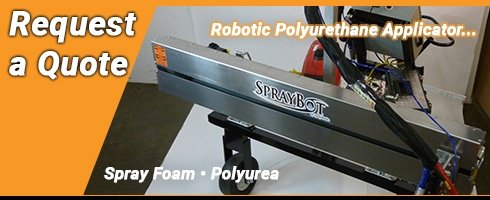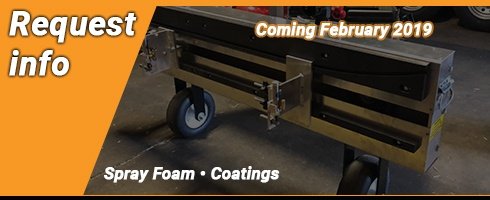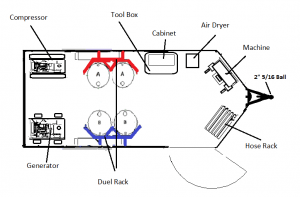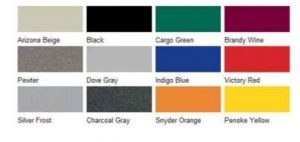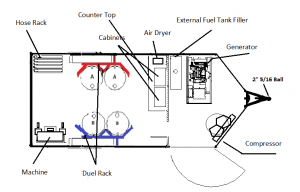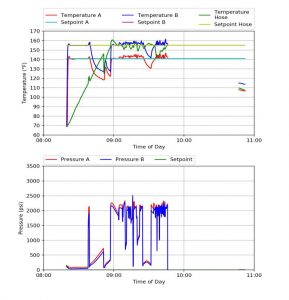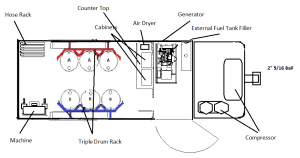The Process for Applying Spray Foam on Flat Roofing
The process of applying flat roofing spray foam isn’t much different than other projects for spray foam, but there are still some key steps to follow, which include:
- Collecting equipment and materials – Gather the equipment you need, including your spray foam rig, hoses, spray gun, appropriate PPE, and more
- Preparing the surface – Clean the surface by removing any dirt, debris, or loose materials and fix any damage or leaks
- Considering the weather – Confirm that the weather is appropriate for spray foam application, taking caution with high winds, resulting in overspray on vehicles or property below. Ambient temperatures and weather can also impact the quality of your spray foam, so make sure you check your material SDS for proper spraying temperatures.
- Choosing the best foam for the project – Select the most appropriate spray foam for the roof and specific climate (closed-cell foam is typically used for flat roofs due to its water-resistant properties). There is foam specific to roofing.
- Applying the spray foam – Ensure that your mixture is created according to manufacturer instructions in your SDS, then apply the spray foam
- Inspecting for quality control – Inspect the flat roofing spray foam application and identify any irregularities or gaps, and then fix them accordingly before sealing with a coating spray.
As always, you will want to address any customer concerns throughout the process. If you are in a populated area with cars, be sure to check for spray foam overspray and have a process in place for handling it.
Our Favorite Tips for Applying Spray Foam on Flat Roofing
If you are looking for the most seamless application experience, be sure to read through some of our favorite tips. Assuming your roof is “ready-to-spray”:
- Never assume there isn’t a slope because slope comes in many variables, even with a supposed “flat roof”. Most buildings are old and have a 1/16” slope every 12 feet. Even today, many commercial roofs are still built this way.
- Test the roof to find out what thicknesses you need, using a transit measuring tool (survey).
- Pick out a section of roof that you can complete in a timely manner, so you can get the coating started early enough to cure that day. This will prevent leaving foam roofing exposed.
- Use consistent and even arm motions to promote uniform coverage or use robotic equipment like the Spraybot.
FAQs on Flat Roofing Spray Foam Application
How is applying spray foam on flat roofing different from other applications?
The sloped angle of a regular roof provides a means of water runoff. On a flat roof, proper drainage is still essential to prevent water pooling, but achieving it might require some creativity. With this in mind, consider applying the spray foam in a way that creates appropriate slopes that direct water toward drains.
Additionally, flat roofs are more exposed to direct sunlight, which can degrade the effectiveness of spray foam over time. To make the most of the flat roofing spray foam application, we suggest adding a protective coating that can shield the foam from UV rays to enhance its durability.
What type of spray foam is most suitable for flat roofs?
Closed-cell roofing spray foam is the best option for flat roofing spray foam because it has higher compressive density, water resistant, and structural strength. This allows it to act as both an insulation and vapor barrier.
How long does it take to complete a flat roofing spray foam application?
The duration of a spray foam application will depend on certain factors like roof size, weather conditions, and the specific time the spray foam is applied. If the surface needs heavy preparation or multiple layers, this will add time as well.
Diving into Spray Foam Application for Flat Roofing
If you are hesitant to start applying spray foam on flat roofing, SprayWorks Equipment is here to help! We host a variety of classes so that you can gain experience and understand techniques for the best spray foam application possible. Specifically, our commercial roofing training is a two-day, hands-on training course that allows individuals to gain experience working with the best equipment while practicing essential skills.
Whether you are a beginner or a pro, you can take this class, as it is designed to supply information for spray foam applicators of all skill levels. Additionally, it is flexible enough to be adjusted to fit the goals of your specific business.
Skills you can expect to learn include:
- Safety measures
- Code compliance
- Estimating
- Identification and preparation of substrates
- Installation methods for building a spray foam roof
- Marketing
- Operation of equipment
- Application of various coatings
Be sure to sign up for this course if you are looking for more information on applying spray foam to flat roofing. Our instructors have over 60 years of combined experience and look forward to teaching you via real-life examples during training!
Contact Us for More Information
For more information on how to master the application of spray foam on flat roofing, be sure to contact us today.
We look forward to seeing you in one of our classes!

